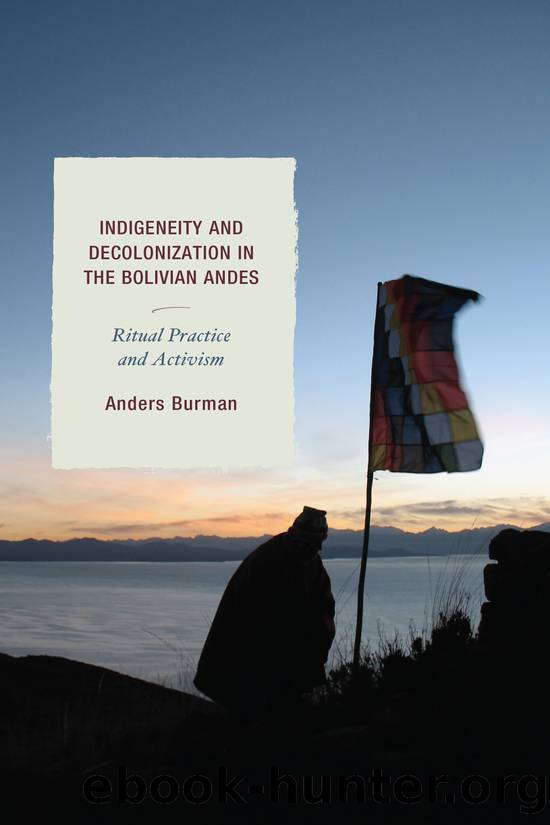Indigeneity and Decolonization in the Bolivian Andes by Burman Anders;

Author:Burman, Anders;
Language: eng
Format: epub
Publisher: Lexington Books/Fortress Academic
Part II
The Cure (Ay. Qulla)
Chapter 6
Native Being
One cannot speak of âbeingâ in the Andes without speaking of ajayu. Chapter 4 explored Aymara notions of illness and pathological states and behaviors related to the ajayu. It also described the intertwining of Aymara ailments such as ajay sarqata (spirit loss) and notions of Colonialism as illness. The present chapter deals with ritual therapeutic practices that are designed to cure the different maladies that can afflict the ajayu. It also explores the cross-fertilization between such ritual practices and decolonizing activism.
Diagnosis
Whenever a cliente visits Don Carlos at Qulla Uta, the small Medicine House where he works when he is not tutoring doctors in the Health Ministry, a thorough diagnosis is made. Don Carlos uses a variety of diagnostic methods depending on the case. There are, however, some standard methods. Although the order in which they are used varies, the routine is often as follows.
Firstly, Don Carlos listens to the clienteâs story in order to obtain basic information, such as the symptoms and their duration and whether the cliente has been to any extraordinary places (such as mountain peaks, ravines, chullpares1) or whether there is anyone who may hold envidia (envy) towards them. During this initial dialogue, Don Carlos checks things such as the clienteâs way of breathing â the ajayu is associated with breathing and any deviation from normal breathing may indicate that something associated with the ajayu is wrong â and the clienteâs gaze. An odd gaze, such as looking at the floor without looking people in the eyes, is interpreted not only as antisocial but also as a symptom of the person being under âstrangeâ influence. For instance, a kharsuta, a person who has been subjected to the misdeeds of the fat-stealing monstrous figure called kharisiri, is said to avoid looking people in the eyes (see chapter 3 and 5).
Secondly, the clienteâs temperature is checked by Don Carlos simply putting his hand on the clienteâs forehead.
Thirdly, the clienteâs pulse is checked, not for frequency but for strength â a measure of the clienteâs health status.
Finally, the most crucial diagnostic method is begun: the coca leaves are read (for more exhaustive accounts see e.g. Carter and Mamani 1986; Fernández Juárez 1999, 131â34; Chambi Pumakahua 2007). To begin with, some leaves are tossed over the tari in order to provide a general overview of the situation. Then with each reading turn, more information is revealed and before long a preliminary diagnosis is made and then reconfirmed by further reading. Once a definite diagnosis has been made, appropriate treatments are chosen also by scrutinizing the coca leaves.
Calling for the Ajayu
There are many maladies caused by spirit loss. Small childrenâs ajayus are easily lost since they are still not firmly connected to their bodies. One major task for any practicing Maestro is therefore to âcall forâ lost ajayus. Usually, though, calling for a lost ajayu is a trivial procedure that any parent should know how to perform. When a small child is frightened by a barking
Download
This site does not store any files on its server. We only index and link to content provided by other sites. Please contact the content providers to delete copyright contents if any and email us, we'll remove relevant links or contents immediately.
The Vikings: Conquering England, France, and Ireland by Wernick Robert(79939)
Ali Pasha, Lion of Ioannina by Eugenia Russell & Eugenia Russell(40158)
The Conquerors (The Winning of America Series Book 3) by Eckert Allan W(37149)
The Vikings: Discoverers of a New World by Wernick Robert(36923)
Cecilia; Or, Memoirs of an Heiress — Volume 1 by Fanny Burney(32438)
Cecilia; Or, Memoirs of an Heiress — Volume 2 by Fanny Burney(31875)
Cecilia; Or, Memoirs of an Heiress — Volume 3 by Fanny Burney(31858)
Empire of the Sikhs by Patwant Singh(22978)
The Secret History by Donna Tartt(18857)
Hans Sturm: A Soldier's Odyssey on the Eastern Front by Gordon Williamson(18488)
Cat's cradle by Kurt Vonnegut(15189)
Pimp by Iceberg Slim(14398)
Sapiens: A Brief History of Humankind by Yuval Noah Harari(14256)
Talking to Strangers by Malcolm Gladwell(13232)
Norse Mythology by Gaiman Neil(13211)
Leonardo da Vinci by Walter Isaacson(13189)
4 3 2 1: A Novel by Paul Auster(12289)
Underground: A Human History of the Worlds Beneath Our Feet by Will Hunt(12027)
The Radium Girls by Kate Moore(11930)
